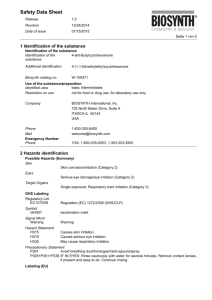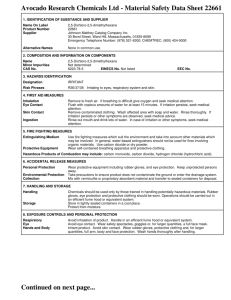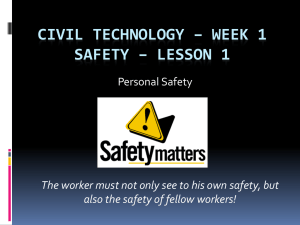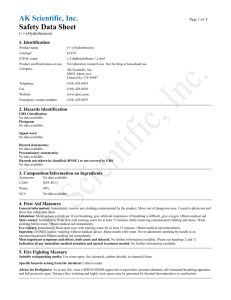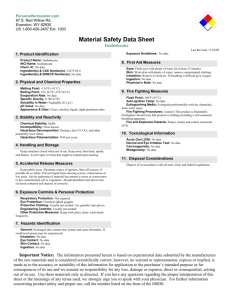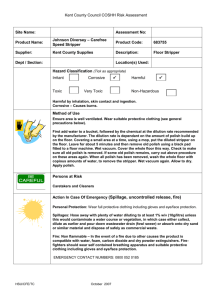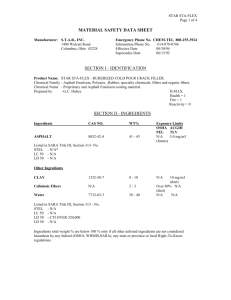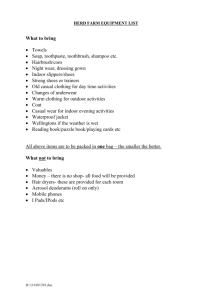Safety Data Sheet
advertisement
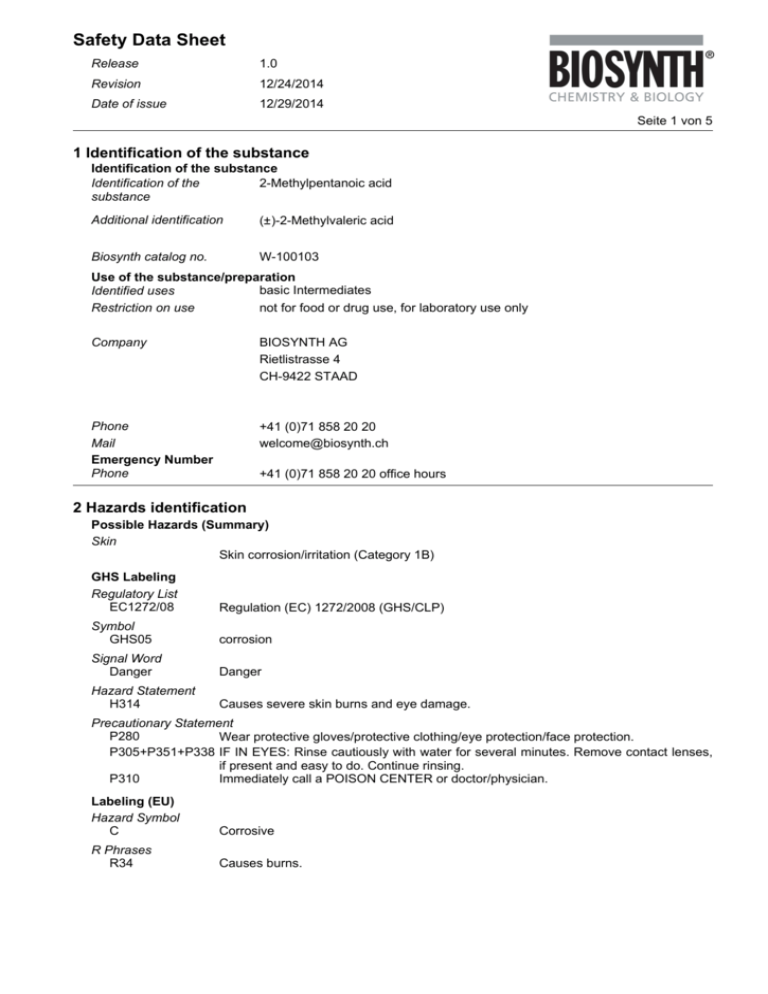
Safety Data Sheet Release 1.0 Revision 12/24/2014 Date of issue 12/29/2014 Seite 1 von 5 1 Identification of the substance Identification of the substance Identification of the 2-Methylpentanoic acid substance Additional identification (±)-2-Methylvaleric acid Biosynth catalog no. W-100103 Use of the substance/preparation basic Intermediates Identified uses Restriction on use not for food or drug use, for laboratory use only Company BIOSYNTH AG Rietlistrasse 4 CH-9422 STAAD Phone Mail Emergency Number Phone +41 (0)71 858 20 20 welcome@biosynth.ch +41 (0)71 858 20 20 office hours 2 Hazards identification Possible Hazards (Summary) Skin Skin corrosion/irritation (Category 1B) GHS Labeling Regulatory List EC1272/08 Regulation (EC) 1272/2008 (GHS/CLP) Symbol GHS05 corrosion Signal Word Danger Danger Hazard Statement H314 Causes severe skin burns and eye damage. Precautionary Statement P280 Wear protective gloves/protective clothing/eye protection/face protection. P305+P351+P338 IF IN EYES: Rinse cautiously with water for several minutes. Remove contact lenses, if present and easy to do. Continue rinsing. P310 Immediately call a POISON CENTER or doctor/physician. Labeling (EU) Hazard Symbol C Corrosive R Phrases R34 Causes burns. Safety Data Sheet S Phrases S26 S27 S36/37/39 S45 W-100103 Seite 2 von 5 In case of contact with eyes, rinse immediately with plenty of water and seek medical advice. Take off immediately all contaminated clothing. Wear suitable protective clothing, gloves and eye/face protection. In case of accident, or if you feel unwell, seek medical advice immediately (show the label where possible). Additional Information Caution! To the best of our knowledge the toxicological properties of this material have not been thoroughly investigated. 3 Composition/information on ingredients Substance related information 2-Methylpentanoic acid Substance name Synonymes (±)-2-Methylvaleric acid Cas No. [97-61-0] Formula C6H12O2 4 First aid measures First Aid: Eye Immediately flush eyes with plenty of flowing water for 10 to 15 minutes holding eyelids apart. Consult an ophthalmologist. First Aid: Skin Wash immediately with plenty of water and soap for at least 15 minutes. Remove contaminated clothing and shoes. Wash contaminated clothes before reuse. Call a physician. First Aid: Ingestion Wash out mouth with water provided person is conscious. Call a physician. First Aid: Inhalation Remove casualty to fresh air and keep warm and at rest. If breathing is irregular or stopped, administer artificial respiration. Call a physician. Hints for Physician: Treatment Treat symptomatically. 5 Firefighting measures Extinguishing Media Suitable foam, dry extinguishing powder, carbon dioxide (CO2), water spray jet Hazards During Fire-Fighting toxic fumes Protective Equipment for Fire-Fighting Wear a self-contained breathing apparatus and chemical protective clothing. Fire-Fighting/Further Advice Do not inhale explosion and combustion gases. Collect contaminated fire extinguishing water separately. This must not be discharged into drains. Move undamaged containers from immediate hazard area if it can be done safely. 6 Accidental release measures Safety Data Sheet W-100103 Seite 3 von 5 Personal Precautions Wear breathing apparatus if exposed to vapours/dusts/aerosols. Provide adequate ventilation. Environmental Precautions Do not allow to enter into soil/subsoil. Do not allow to enter into surface water or drains. Ensure all waste water is collected and treated via a waste water treatment plant. Methods for Cleaning or Taking Up not available Further Accidental Release Measures Collect in closed and suitable containers for disposal. Clear contaminated areas thoroughly. Ventilate affected area. 7 Handling and storage Handling Handling advice Avoid contact with skin, eyes and clothing. Avoid ingestion and inhalation. Avoid prolonged or repeated exposure. Remove contaminated clothing and wash before reuse. Wash thoroughly after handling. Storage Storage temperture store at room temperature Storage Requirements (SDS) Keep away from incompatible substances. Store in a cool, dry, well-ventilated area away from incompatible substances. 8 Exposure controles/personal protection Exposure controles Industrial Hygiene Mechanical exhaust required. Safety shower and eye shower. Personal Protective Equipment Respiratory Protection Wear NIOSH/MSHA or European Standard EN 149 approved respirator. Hand Protection Wear compatible chemical-resistant gloves to prevent skin exposure. Eye Protection Wear appropriate protective eyeglasses or chemical safety goggles as described by OSHA. Body Protection Wear compatible chemical-resistant gloves and clothing to prevent skin exposure. Advice on Safe Handling Wash contaminated clothing before reuse. Wear appropriate protective clothing to prevent exposure. 9 Physical and chemical properties Color colorless Form powder Phase Transition Solid/Liquid -85 °C Safety Data Sheet W-100103 Seite 4 von 5 Phase Transition Liquid/Gas 197 °C Molar Mass 116.16 g/mol Density 0.916 g/cm3 Flash Point 91 °C 10 Stability and reactivity Conditions to Avoid (SDS) incompatible materials Substances to Avoid (SDS) strong oxidizers Decomposition Products carbon dioxide (CO2), carbon monoxide 11 Toxicological information Acute Oral Toxicity LD50 oral, Rat, 2,040 mg/kg Acute Dermal Toxicity LD50, rabbit, 2,500 mg/kg Other Relevant Toxicity Information Only selected Registry of toxic effects of chemical substances (RTECS) data is presented here. See actual entry in RTECS for complete information. 12 Ecological Information Biodegradation no data available Bioaccumulation no data available Distribution in Environment no data available 13 Disposal considerations Advice on Disposal and Packaging Advice on Disposal Dissolve or mix the material with a combustible solvent and burn in a chemical incinerator equipped with an afterburner and scrubber; observe all federal, state and local environmental regulations. Dispose of waste according to Kreislaufwirtschafts- und Abfallgesetz (KrW-/AbfG). Advice on Packaging not available 14 Transport information Safety Data Sheet W-100103 Seite 5 von 5 Road Transport (ADR/GGVS) UN No. 3265 Class(es) 8 Class(es) II Proper Shipping Name Corrosive liquid, acidic, organic, n.o.s. (2-Methylpentanoic acid) Air Transport (IATA) UN No. 3265 Class(es) 8 Class(es) II Proper Shipping Name Corrosive liquid, acidic, organic, n.o.s. (2-Methylpentanoic acid) 15 Other regulations Other Regulations not available 16 Additional information GHS Labeling Regulatory List EC1272/08 Regulation (EC) 1272/2008 (GHS/CLP) Symbol GHS05 corrosion Signal Word Danger Danger Hazard Statement H314 Causes severe skin burns and eye damage. Precautionary Statement P280 Wear protective gloves/protective clothing/eye protection/face protection. P305+P351+P338 IF IN EYES: Rinse cautiously with water for several minutes. Remove contact lenses, if present and easy to do. Continue rinsing. P310 Immediately call a POISON CENTER or doctor/physician. BIOSYNTH provides this MSDS in good faith. No representation is made as to the accuracy or comprehensiveness of the data and BIOSYNTH shall not be liable for any errors in the data. No representation is made as to the fitness of the data or of the materials for any particular use. No representation or warranty is made as to damages or injury. User assumes all responsibility for compliance with all laws and regulations implicated by use of this material.
